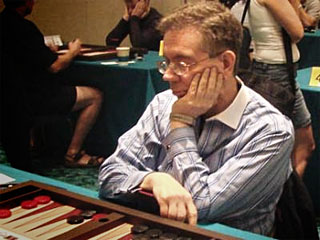|
| Magriel's NYT Columns |

Bill Robertie The North American Backgammon Championships, which started this month, is a special tournament limited to 16 of this country’s best players. The eight preliminary rounds are now being played at different cities around the country. Final rounds will be played in Las Vegas next week concurrently with the Plimpton Cup, an amateur tournament with more than 1,000 players.
The format of each round is best three out of five 7-point matches. So far, Oswald Jacoby of Dallas has defeated Chuck Papazian of San Francisco. Jason Lester of New York beat Barclay Cooke of New York. Kyle Larsen of San Francisco defeated Michael Maxakuli of Las Vegas. Malcolm Davis of Dallas beat Hugh Sconyers of Los Angeles. Marie Reynolds of North Carolina defeated Fran Goldfarb of New York. Mike Carson of Philadelphia won over Tom Gilbert of Los Angeles. Bill Robertie of Boston defeated Paul Magriel in a match earlier this month in Cambridge, Mass.
Robertie, new young player, is already considered to be the best in New England. Because he has almost never competed outside the Boston area, he has not yet established a national or international reputation. However, his fine performance during his playoff against Magriel shows the talent that he is developing. Undoubtedly, he will soon be a recognized contender at all levels of play.
The diagrammed position illustrates the skillful play of Robertie (Black) at a crucial juncture in his final 7-point match against Magriel (White). The score was tied 5–5 and Black has just doubled: with the cube at the 2 level, this would be the deciding game of the match.
|
5
MATCH TO 7 5 |
| Black to play 6-1. |
With a roll of 6-1, the obvious play is simply 13/6, moving one man all the way from Black’s mid-point (13-point) into his home board. Robertie, however came up with a more forceful alternative. He realized that now was the time to take advantage of White’s comparatively weaker position.
The correct play is 13/7, 8/7, making the bar-point (7-point) but leaving a single man slotted on the 8-point.
|
|
|
Rollout
 Tom Keith 2013 |
|
Match to 7 White 5, Black 5 White owns 2-cube Black rolls 6-1 1296 games with VR Checker play: 2-ply Cube play: 3-ply Red |
| 6-1: | Game | G | BG | Equity | ||||
| 1 | 13/7, 8/7 |
W L |
.6038 .3962 |
.1852 .0898 |
.0210 .0061 | +0.2075 |

| (b) |
| 2 | 13/12, 13/7 |
W L |
.6030 .3970 |
.1743 .1206 |
.0223 .0078 | +0.2060 | (0.0015) | |
| 3 | 13/12, 10/4 |
W L |
.5862 .4138 |
.1698 .0772 |
.0126 .0030 | +0.1724 | (0.0351) | |
| 4 | 13/6 |
W L |
.5823 .4177 |
.1589 .0821 |
.0144 .0071 | +0.1646 | (0.0429) | (a) |

|
|

